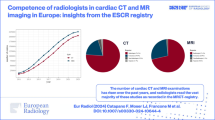Abstract
The present short review describes the physiological effects of rapid transient changes in cardiac extracellular ions (electrolytes) caused by the bolus of x-ray contrast medium (CM) during coronary angiography. The underlying hypothesis is that as the molecular and osmolal toxicities of modern CM is low, cardiac side-effects result mainly from secondary and biphasic ionic changes which occur during the initial washout phase and during the later re-introduction of blood. In particular the washout pattern for sodium (Na) and calcium (Ca) has great influence on cardiac function. Thus the Na-Ca exchange system of the cardiac cell membrane plays a pivotal role in controlling intracellular Ca and contractility during very brief coronary bolus injections of both nonionic and ionic CM. The nonionic dimer iodixanol is hyposmolal without an additive. Animal experiments demonstrate the value of taking myocarcardial Na-Ca relationships into careful consideration when adding ions to iodixanol and formulating an isotonic CM like Visipaque
Similar content being viewed by others
References
Almén T (1990) Contrast media. The relation of chemical structure, animal toxicity and adverse clinical effects. Am J Cardiol 66:2F-8F
Dawson P, Howell M (1986) The nonionic dimers: a new class of contrast agents. Br J Radiol 59:987–991
Murdock DK, Euler DE, Kozeny G, Murdock JD, Loeb HS, Scanlon PJ (1984) Ventricular fibrillation during coronary angiography in dogs: the role of calcium-binding additives. Am J Cardiol 54:897–901
Morris TW (1988) Ventricular fibrillation during right coronary arteriography with ioxaglate, iohexol and iopamidol in dogs. Invest Radiol 23: 205–208
Jynge P, Blankson H, Schjøtt J, Holten T, Øksendal AN (1995) Contractile responses to electrolyte changes during coronary bolus perfusion: a comparative study in isolated rat, guinea pig and rabbit hearts. Invest Radiol 30: 173–180
Bers DM (1991) Excitation-contraction coupling and cardiac contractile force. Chapter 3: Possible sources and sinks of activator calcium. Kluwer Academic Publishers, Dordrecht, pp 33–48
Bers DM (1991) Excitation-contraction coupling and cardiac contractile force. Chapter 5: Na/Ca exchange and the sarcolemmal Ca-pump. Kluwer Academic Publishers, Dordrecht, pp 71–92
Bers DM (1991) Excitation-contraction coupling and cardiac contractile force. Chapter 8: Control of cardiac contraction by SR Ca release and sarcolemmal Ca fluxes. Kluwer Academic Publishers, Dordrecht, pp 149–170
Langer GA (1990) Calcium and the myocardium: Physiologic and pathologic processes. Adv Card Surg 1: 55–75
Bers DM (1991) Excitation-contraction coupling and cardiac contractile force. Chapter 9: Cardiac inotropy and Ca overload. Kluwer Academic Publishers, Dordrecht, pp 171–204
Toda N, Ayajiki K, Toda H, Hatano Y, Okamura T (1992) Mechanisms underlying mannitol induced relaxation in isolated monkey cerebral arteries. Am J Physiol 262: H897–902
Hamill JVW, Lane JW, McBride DW Jr (1992) Amiloride. A molecular probe for mechanosensitive channels. Trends Pharmacol Sci 13: 373–376
Hearse DJ, Braimbridge MV, Jynge P (1981) Protection of the ischemic myocardium: cardioplegia. Chapter 7: Components of cardioplegic solutions. Raven Press, New York, pp 209–299
Jynge P, Holten T, Øksendal AN (1993) Sodium-calcium balance and cardiac function with isotonic iodixanol: an experimental evaluation in the isolated rat heart. Invest Radiol 28: 20–25
Blankson H, Holten T, Øksendal AN, Jynge P (1996) Changes in contractile function with low-osmolal and isosmolal contrast media for coronary angiography. Acta Radiol (in press)
Bååth L, Almen T (1989) Reduction of the risk of ventricular fibrillation in the isolated rabbit heart by small additions of electrolytes to nonionic monomeric contrats media. Acta Radiol 30: 327–332
Bååth L, Besjakov J, Øksendal AN (1993) Sodium-calcium balance in nonionic contrast media. Effects on the risk of ventricular fibrillation in the isolated rabbbit heart. Invest Radiol 28: 223–227
Jacobsen EA, Kløw NE, Mortensen E, Refsum H (1991) Sodium addition to nonionic contrast media. Effects on cardiac monophasic action potentials and hemodynamics in a dog model. Invest Radiol 26: 888–893
Pedersen HK, Jacobsen EA, Refsum H (1994) Contrast media induced ventricular fibrillation: An experimental study of the effects of dimeric contrast media during wedged catheter injection in dogs. Acad Radiol 1: 136–144
Author information
Authors and Affiliations
Rights and permissions
About this article
Cite this article
Jynge, P. Sodium-calcium balance in coronary angiography and experimental experience with iodixanol. Eur. Radiol. 6 (Suppl 2), S8–S12 (1996). https://doi.org/10.1007/BF02342565
Issue Date:
DOI: https://doi.org/10.1007/BF02342565




